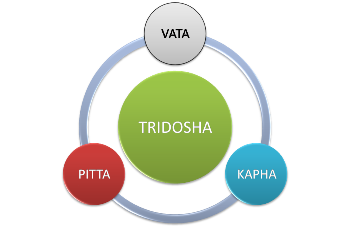The Concept of Tri-Dosha
Tri-Dosha is the science of understanding our nature or our constitution. It defines three fundamental principles that govern the overall functions of our body and stables our emotional level. In other words, Tri-Dosha is a combination of three basic principles of energy or biological humor. The three components of Tri-Dosha are Vata, Pitta, and Kapha Dosha. The balance of all Tri-Dosha leads to a healthy and sound body while imbalance Tri-Dosha leads to the diseased condition.
In a healthy person balancing, the Tri-Dosha means to restore the original body type dosha combination, with a slight adjustment to suppress dominant dosha in the body. In a diseased condition, it means to bring back all the three doshas to normal proportions i.e. 33% each. However, because of the normal human diet and all other factors, it is almost impossible to maintain exactly 33% of each dosha. Its level always fluctuates.
The concept of Tri-Dosha has always been a mystery. They are the three energetic principles that underpin and activate the more physical aspects of Pancha bhuta. The three vital senses of humor (Vayu, pitta, and Kapha) maintains the integrity of organisms by maintaining, creating, and diffusing strengths. Wherever there is life, there is a vital role of Tri-Dosha. The functions of the three vital senses of humor of Tri-Dosha are given below.
Function of Vata dosha
* It is responsible for the movement of blood in blood vessels.
* It is responsible for the movement of the neck and all body parts.
* It helps in the movement of food and nutrients.
* It is responsible for the movement of eyeballs, hands, and legs.
Vata means the substance called air and is directly related to the element called air. Its presence provides a sensation to our body i.e. vibration and movement. It is a symbolic mobilizing agent for bodily energy.
Function of Pitta Dosha
* It is directly involved with digestion and metabolism.
* It controls the produced energy.
* It helps to maintain the body temperature.
* It enhances intelligence, courage, valor, etc.
Pita means the substance called bile and is related to the substance called fire. Bodily bile is a vital metabolic substance that contains metabolic products. It is a symbolic agent for energy or heat.
Function of Kapha Dosha
* It confers stability and compactness.
* It confers lubrication, firmness of the joints.
* It is the cause for mental capacity to withstand or withhold emotions, strains, etc.
* It imbibes forgiveness quality in a person.
Kapha means mucous and is related to the element of water. It is a symbolic agent for the nutrient source of bodily energy.
Tri-Dosha is the central and primary concept of Ayurveda medicine. All the Ayurvedic physicians strongly believe that these ancient ideas are based on spiritual knowledge discovered by rishi munis. The concept of Tri-Dosha allows Ayurvedic physicians to examine the status of the whole system homeostasis.
Interrelationship of Tri-Doshas Vata dosha, pitta dosha, and Kapha dosha
The sensations, movements, and vibrations generated by the Vata via the nervous system controls and regulates the supply of the energy released by Kapha. The supply of vital mucous controls and regulates sensation, movements, and vibrations within the nervous system. Therefore, the substance of Vata and Kapha regulates and controls each other. Again, both of them work in a team to control and regulate pitta.
The doshas ensure that all mahabhutas are held together and exert their functions in synergism for the optimum function of the human body. Vata is the force that holds together Akasha and Vayu mahabhuta. Pitta is the force that holds together Agni and Jala mahabhuta. Kapha is the force that holds together Prithvi and Jala mahabhuta.
The balance of all three senses of humor helps to improve your body condition and makes you healthy. Here are some keys that can help you to balance your doshas:
- Going to bed before 10 PM.
- Maintaining a good daily routine.
- Exercise in moderation and not to the point of exhaustion.
- Protecting yourself from the mid-day sun.
- Taking time to eat heartily, favor cool lunch.
- Pranayama breathing practice.
- Taking a brisk walk soon after sunrise.
- Awaken by 6 AM.
